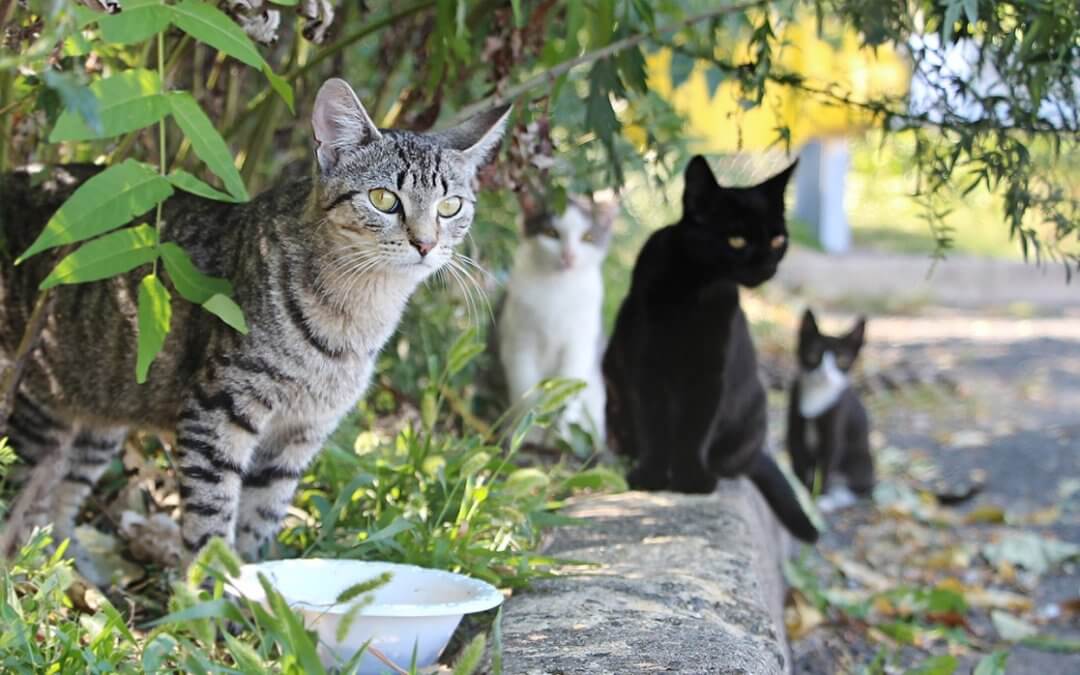A TNR or Trap-neuter-return program is a humane alternative to trapping and euthanising cat populations. This is a method for managing the number of free-roaming, homeless cats in a specific geographical area. With this type of program, homeless cats will be humanely trapped. Then the animals will be evaluated and sterilised by a practicing veterinarian. Before being returned to their natural habitat, in many other countries operating TNRs they will also be vaccinated against rabies.

Photo by Aleksandar Popovski on Unsplash
Are There Benefits to Creating a TNR?
The principal benefit of creating a TNR program is that it will eventually lower the population of local free-roaming cats and it will do so much more effectively than trap-and-kill policies have managed to date.
Local animal lovers across New Zealand regularly provide food, water, and often shelter for local strays. But when left unmanaged, these cat populations will undoubtedly proliferate over time, leading to increased calls for population control through lethal methods. A TNR offers an opportunity to manage cat populations in a humane way and integrate adoption activities to find cats forever homes.
Interrupting breeding and helping cats find permanent homes through adoption, will in the long term prove more effective in population control than simply capturing some and killing them.
Benefits and More Benefits
Aside from this important primary benefit, there are several other important advantages for the community that decides to create a TNR. Among these are:
- Reduction of cat-carried diseases. Cats carry zoonotic diseases, such as toxoplasmosis, and rabies, known to be dangerous to humans, as well as roundworms and hookworms. TNRs can contribute to better health in stray cat populations, and hence improve community health and safety.
- A reduction in the costs associated with shelters as admissions drop.
- Reducing and working toward the elimination of nuisance behavior through sterilisation.
- Improving the lives of many stray male cats as aggressive behavior related to sexual maturity diminishes through neutering.
- Improving the lives of female strays who are no longer forced into repeated pregnancies, deliveries, and defending those kittens until independent.
An added benefit for both animal control personnel, shelter workers, and animal care volunteers is eliminating the stress of repeated and unnecessary killings of innocent animals as a method of birth control.
With a positive work environment, these service professionals and volunteers experience less employee turnover as well as a better self-image and a better public image. The time and resources normally dedicated to euthanising can be better used for the care of shelter animals and the development of adoption programs and correlated activities.
The better public image that a TNR affords may also increase volunteering. Very few people want to volunteer for trapping and euthanisation programs.
A TNR, on the other hand, affords volunteers the satisfaction of knowing that they are making a difference in the lives of the cats as well as of the community.
These volunteer caregivers assist in trapping, feeding, and monitoring the local stray cat colonies, and they will continue to do so when neutered cats are returned to their local colony.
Frequent caregiving and monitoring also become an invaluable component of a TNR program, Animal Health and Welfare Regulations require TNR programs to have caretakers returning cats. They are not simply returned with the promise of food and water. Cats must be monitored daily and receive veterinary care for medical concerns. Many stray cats will suffer from poor dental hygiene, trauma and injury.
New cats will be more easily identified by people who know the colony well. This allows for the sterilising of new colony members. Volunteers not connected with cat rescues are discouraged from applying TNR individually because of these requisites.
Why Choose TNR Instead of Lethal Cat Population Control?
TNR offers an alternative to trap-and-kill methods that obviously have not worked in resolving problems.
Euthanisation has been used for decades, and yet large colonies of free-roaming cats still exist. Killing innocent animals is also not a popular or palatable solution for controlling stray cat populations.
Why Has Euthanisation Failed?
Catch and euthanise will reduce cat numbers temporarily and requires resources as no one will offer to help trap and euthanise for free. It is therefore expensive and hence unsustainable long term because as long as cats are not sterilised, catching and killing will be necessary forever. [New cats will come into the empty territory or any cats that were not killed will increase their reproduction due to increased prey resulting from previously reduced cat numbers in a vicious cycle. editor’s addition]

Photo by Melina Kiefer on Unsplash
A Final Thought
TNR can achieve consensus. TNR programs involve volunteers, colony caretakers, and many concerned citizens. These people most often work for free. Given that paying trappers to trap and kill is so resource-consuming and does not resolve the problem, TNR can, in the long term, begin making a difference in population control.
By Elsa Smith
Further resources for more information:
https://www.thenzcatfoundation.org.nz/learn/trap-neuter-return-tnr/
https://www.spca.nz/advice-and-welfare/article/trap-neuter-return-tnr
Photo by Aleksandar Popovski on Unsplash
Are There Benefits to Creating a TNR?
The principal benefit of creating a TNR program is that it will eventually lower the population of local free-roaming cats and it will do so much more effectively than trap-and-kill policies have managed to date.
Local animal lovers across New Zealand regularly provide food, water, and often shelter for local strays. But when left unmanaged, these cat populations will undoubtedly proliferate over time, leading to increased calls for population control through lethal methods. A TNR offers an opportunity to manage cat populations in a humane way and integrate adoption activities to find cats forever homes.
Interrupting breeding and helping cats find permanent homes through adoption, will in the long term prove more effective in population control than simply capturing some and killing them.
Benefits and More Benefits
Aside from this important primary benefit, there are several other important advantages for the community that decides to create a TNR. Among these are:
- Reduction of cat-carried diseases. Cats carry zoonotic diseases, such as toxoplasmosis, and rabies, known to be dangerous to humans, as well as roundworms and hookworms. TNRs can contribute to better health in stray cat populations, and hence improve community health and safety.
- A reduction in the costs associated with shelters as admissions drop.
- Reducing and working toward the elimination of nuisance behavior through sterilisation.
- Improving the lives of many stray male cats as aggressive behavior related to sexual maturity diminishes through neutering.
- Improving the lives of female strays who are no longer forced into repeated pregnancies, deliveries, and defending those kittens until independent.
An added benefit for both animal control personnel, shelter workers, and animal care volunteers is eliminating the stress of repeated and unnecessary killings of innocent animals as a method of birth control.
With a positive work environment, these service professionals and volunteers experience less employee turnover as well as a better self-image and a better public image. The time and resources normally dedicated to euthanising can be better used for the care of shelter animals and the development of adoption programs and correlated activities.
The better public image that a TNR affords may also increase volunteering. Very few people want to volunteer for trapping and euthanisation programs.
A TNR, on the other hand, affords volunteers the satisfaction of knowing that they are making a difference in the lives of the cats as well as of the community.
These volunteer caregivers assist in trapping, feeding, and monitoring the local stray cat colonies, and they will continue to do so when neutered cats are returned to their local colony.
Frequent caregiving and monitoring also become an invaluable component of a TNR program, Animal Health and Welfare Regulations require TNR programs to have caretakers returning cats. They are not simply returned with the promise of food and water. Cats must be monitored daily and receive veterinary care for medical concerns. Many stray cats will suffer from poor dental hygiene, trauma and injury.
New cats will be more easily identified by people who know the colony well. This allows for the sterilising of new colony members. Volunteers not connected with cat rescues are discouraged from applying TNR individually because of these requisites.
Why Choose TNR Instead of Lethal Cat Population Control?
TNR offers an alternative to trap-and-kill methods that obviously have not worked in resolving problems.
Euthanisation has been used for decades, and yet large colonies of free-roaming cats still exist. Killing innocent animals is also not a popular or palatable solution for controlling stray cat populations.
Why Has Euthanisation Failed?
Catch and euthanise will reduce cat numbers temporarily and requires resources as no one will offer to help trap and euthanise for free. It is therefore expensive and hence unsustainable long term because as long as cats are not sterilised, catching and killing will be necessary forever.
Photo by Melina Kiefer on Unsplash
A Final Thought
TNR can achieve consensus. TNR programs involve volunteers, colony caretakers, and many concerned citizens. These people most often work for free. Given that paying trappers to trap and kill is so resource-consuming and does not resolve the problem, TNR can, in the long term, begin making a difference in population control.


Thank you for educating your readers about TNR programs’ benefits